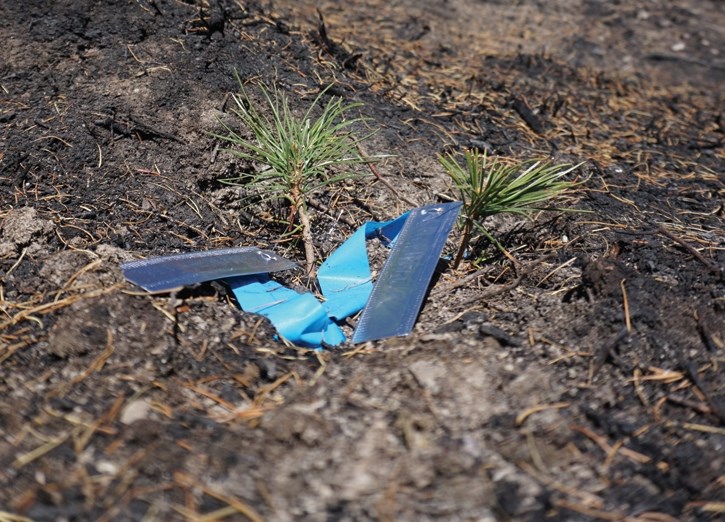Endangered whitebark pine trees are getting a helping hand in Kootenay National Park.
Parks Canada crews planted more than 1,000 whitebark pine seedlings in the aftermath of last summer’s Verdant Creek wildfire, which burned about 18,000 hectares in Kootenay National Park and neighbouring Assiniboine Provincial Park.
The fire burned through areas of important habitat of whitebark pine, which is listed as an endangered species under Canada’s Species at Risk Act (SARA). In Canada, the tree is restricted to high mountain elevations in British Columbia and Alberta.
Officials say it’s an important tree for a host of reasons, including for wildlife, such as red squirrels, grizzly bears and Clark’s nutcrackers that love feeding on its large, fatty, and nutritious seeds.
“Whitebark pine has the same protection as a killer whale and it’s rapidly disappearing from our mountain landscape,” said Jed Cochrane, a Parks Canada fire and vegetation specialist during a Bow Valley Naturalists’ presentation on Jan. 24.
“We’re sort of helping whitebark pine along because if we don’t, they’re not going to do it on their own. This is one opportunity where we can use the Verdant fire, and the habitat created, to try to help the whitebark pine.”
Whitepine blister rust alone is projected to cause a decline of more than 50 per cent of the species over a 100-year time period.
Add the effects of mountain pine beetle, climate change, and 100 years of fire suppression, and this long-lived five-needled pine is expected to decline even further.
“It lives at high elevation, which occupies a really narrow niche climatically,” said Cochrane.
“It’s not going to move at the same kind of speed that it needs to in order to respond to climate change.”
Fire is a definite plus for whitebark pine, but with fires being suppressed, there’s been less habitat for the sun-loving species to grow.
“It comes in immediately after fire and that’s its competitive advantage,” said Cochrane.
“Without fire, shade tolerant species like Engelmann spruce and subalpine fir grow in and outcompete the whitebark pine and eventually whitebark loses the battle – so we need fire.”
Whitebark pine also has a fascinating relationship with Clark’s nutcrackers, which use their dagger-like beaks to rip into pinecones and pull out large seeds which they stash in a pouch under their tongue and then carry away to bury for winter.
Each bird buries tens of thousands of seeds each summer and remembers the locations of most of them. Seeds they don’t retrieve play a crucial role in the growth of new pine forests.
“The nutcracker fills its sublingual pouch with 60 to 70 pine nuts and flies around the landscape, caches them, and then those grow into future whitebark pine trees,” said Cochrane.
“That’s the only way these seeds spread so it’s reliant on Clark’s nutcracker.”
In addition, Cochrane said research has shown Clark’s nutcrackers prefer to stash their cache in burned areas, which speaks to the importance of fires.
“Whitebark pine loves to grow after fires and Clark’s nutcracker likes to cache there, so it works well for both of them,” he said.
“With less fire on the landscape we see the opportunity for caching and less opportunity for regeneration and more competition.”
The Verdant Creek fire burned some whitebark pine habitat and afforded Parks Canada the opportunity for research.
Crews have looked at stands where there’s evidence of blister rust, and other strands that appear healthy.
Some of the trees there have been caged with a protective mesh cover over the cones to prevent Clark’s nutcrackers from eating them.
“It might sound a little bit mean, but we’re doing that because we think that trees we’re collecting cones from are possibly resistant to rust,” said Cochrane.
“We’re looking for trees that demonstrate they have some genetic capability to fight off the rust,” he added.
“We bring them back, we send a whole bunch off to a nursery where we grow them and send a whole bunch of others to send to banks where we store them.”
With this, Parks Canada can then plant seedlings in places like Verdant Creek.
Cochrane said whitebark pine takes 60 to 80 years to produce their first true cones, compared to a species such as lodgepole pine that do this in 15 to 20 years.
“Whitebarks are slow, so we’ve got to help them,” he said. “If nothing is done, it probably won’t be extinct in our lifetime, but in either our children’s or our grandchildren’s lifetime, this tree will disappear.”
The Bow Valley Naturalists are pleased to hear about Parks Canada’s post fire efforts toward whitebark pine restoration, noting it’s important not to forget climate change directly and indirectly threatens these unique trees.
“We will be interested to hear the monitoring results in a few more years,” said Reg Bunyan, a spokesman for BVN.
“Are the newly planted seedlings as rust resistant as the parent trees? Will post fire lodgepole pine outcompete white bark pine seedlings?”




